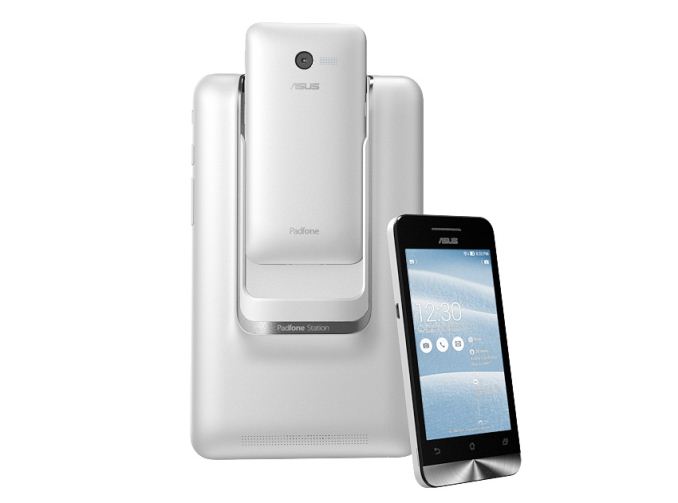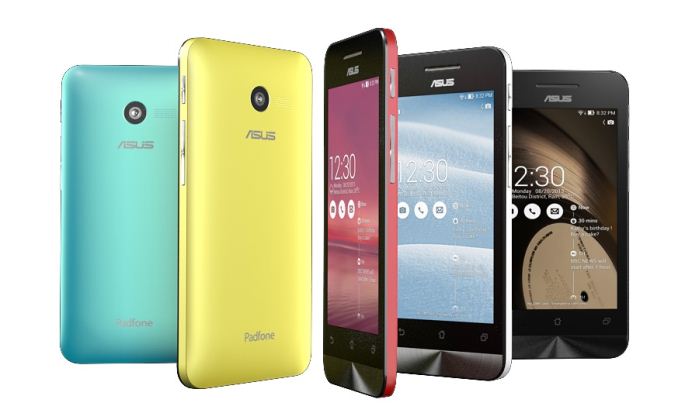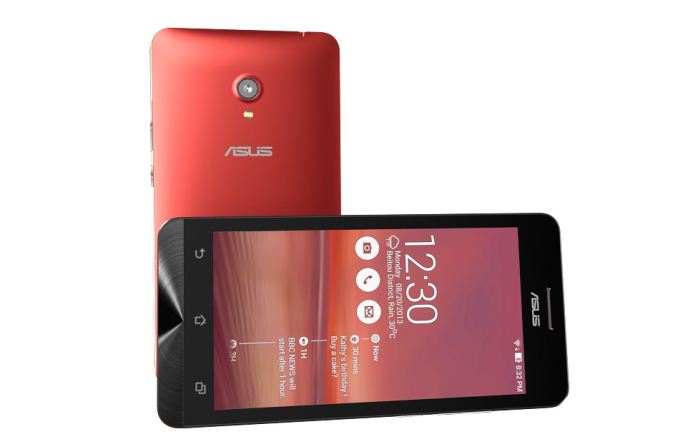ASUS at CES 2014: ROG 27” 1440p 120Hz G-Sync Monitor, Tablets, Smartphones, and a new Transformer Book
by Ian Cutress on January 6, 2014 3:30 PM ESTNew at CES: the ASUS PadFone Mini
The range of PadFone/FonePad from ASUS has been something of a small revolution in terms of having the adaptive device on the go. The current PadFone 2 uses a 4.7” phone that slots into a 10.1” tablet to provide a larger working surface for media consumption and extra battery, whereas the PadFone Infinity has a 5” HD phone with a 10” full HD tablet. ASUS is announcing today the PadFone mini, striking cues from other ‘mini’ branded products in the market – this is a 4 inch smartphone that slots into a 7 inch tablet.
The 4” smartphone is powered by the Intel Atom Z2560 (dual core with hyperthreading) at 1.6 GHz and 8 GB of internal storage, with a microSD slot on hand for another 64 GB. Initially it will ship with Android 4.3, but this will be updated to KitKat/4.4 in due course – ASUS will also apply its own ZenUI on top of Android. The battery is a non-removable 1170 mAH polymer battery, powering an 800x480 IPS+ screen – the tablet segment will give another 2100 mAH battery life while powering a 1280x800 screen.
Other specifications include dual micro-SIM capability, 1GB LPDDR2, support up to DC-HSPA+, a Sony BSI 8MP f/2.0 main camera with a 2MP front camera, 802.11 b/g/n, BT 4.0 and a weight of 116g. The tablet section will add an additional 260g, and both units will be available in a choice of colors.
New at CES: the ASUS ZenFone 4, ZenFone 5 and ZenFone 6
Also in the spirit of attaching numbers relating to the size of the product, ASUS is going for a more mid-range market with the ZenFone series in their new 4 inch, 5 inch and 6 inch formats.
All the models will be running Intel Atom processors, have IPS panels, microSD card slots, Android 4.3 and one of the marketed features of this lineup is ASUS’ ZenUI to increase the user experience. This features the Omlet Chat client for messaging and improved stock Android apps such as email.
No word on release date or pricing as of yet.
| ASUS ZenFone Range | |||
| ZenFone 4 | ZenFone 5 | ZenFone 6 | |
| CPU |
Intel Atom Z2520 1.2 GHz 2C/4T |
Intel Atom Z2580 2.0 GHz 2C/4T |
Intel Atom Z2580 2.0 GHz 2C/4T |
| Screen Size | 4" TFT | 5" IPS | 6" IPS |
| Resolution | 800x480 | 1280x720 | 1280x720 |
| Android | 4.3 | 4.3 | 4.3 |
| Android 4.4 | Soon | Soon | Soon |
| DC-HSPA+ | Yes | Yes | Yes |
| LTE / 4G | No | No | No |
| DRAM | 1GB LPDDR2 | 1GB LPDDR2 | 1GB LPDDR2 |
| Rear Camera | 5MP | 8MP | 13MP |
| Front Camera | 0.3 MP | 2MP | 2MP |
| Battery | 1170 mAh | 2050 mAh | 3230 mAh |
| MicroSD | Yes | Yes | Yes |
| Dimensions | 124.4x61.4x11.2-6.3 mm | 148.2x72.8x10.3-5.5mm | 166.9x84.3x9.9-5.5 mm |
| Weight | 115g | 144g | 200g |

























57 Comments
View All Comments
blanarahul - Monday, January 6, 2014 - link
I just love the new G-SYNC display!A5 - Monday, January 6, 2014 - link
Don't love the price tag, though. $800!klmx - Monday, January 6, 2014 - link
That's a great price for a 2560x1440 display, especially one with g-sync.Sabresiberian - Monday, January 6, 2014 - link
Well it isn't a great price for a regular consumer-grade 2560x1440 these days, when you can buy a good one for under $400. It is maybe justifiable because 1)120Hz IPS (I'm assuming IPS, doesn't actually say so here, if it isn't, the thing is waaaay overpriced), and 2) G-SYNC. I think G-SYNC is estimated to add about $100 to the price of a monitor and 120Hz will add some too, just because it is a "special feature".Really though, $600 would be reasonable, the only way they can get away with $800 is because we are conditioned in the "Western" parts of the world to paying a higher price.
iLovefloss - Monday, January 6, 2014 - link
If it is an IPS, PLS, or AHVA, then the fact that it built for 120Hz would alone justify the price. Plus, you're paying a little extra for a decent warranty and customer service. There are other benefits, but they really don't matter.susuman - Tuesday, January 7, 2014 - link
You got it totally wrong, prices for electronics are cheaper in most western countries, especially in the US. As a matter of fact Asus, Acer, HTC, MSI, Gigabyte etc. products are usually more expensive in Taiwan than in the US.Tim S - Tuesday, January 7, 2014 - link
The G-Sync module set costs ~$200TheJian - Tuesday, January 7, 2014 - link
Link to a DIY kit for $200 please. You can buy the first asus monitor with it in it for $100 extra, so it's $100. There are a few places extorting high INSTALL fees to put it in for you, but that's not the product's price. 1st adopters always get killed on any new tech.cap10 - Tuesday, January 14, 2014 - link
https://store.nvidia.com/store?Action=DisplayPage&...Tasc - Tuesday, January 7, 2014 - link
It's a TN panel, not IPS